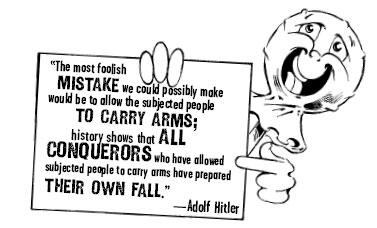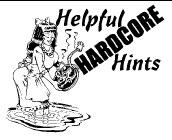When All Hell Breaks Loose (89 page)
Read When All Hell Breaks Loose Online
Authors: Cody Lundin

Now of course the ownership of firearms depends on where you live. Here in Arizona, it's perfectly legal to own and use firearms, but the person thinking about purchasing a home-defense weapon should check local laws before doing so. Certainly, having a weapon to defend yourself makes complete sense, as long as it's purchased and used in a legal way. For home defense, I would recommend a 12-gauge shotgun or a .45 automatic pistol. A woman can manage a 12 gauge if she is properly trained, but a 20 gauge, although not as effective as a 12 gauge, will be sufficient and easier for her to manage. For the shotgun, double-ought (oo) buckshot is most commonly recommended and it's a great round. In some cases, there might be some danger to people in other rooms if this round is used—going through walls and such—and a number four round might be better, but I don't think you can go wrong with either one. It would also be a good idea to have a couple of boxes of slugs on hand as well. The most important thing about firearms is to have one that you're comfortable using and that meets your needs.
As far as precautions around the home, avoiding the confrontation altogether is superior in every way. Take a look at homes around the neighborhood sometime; windows are left open and they just look so easy to break into. Although any home can be broken into, you don't want to make it easier for intruders to do so. It should be difficult and the attacker should have to make a lot of noise. They should have to break windows and give you plenty of warning that they're coming. Various security measures can be done, from roll-down shutters and stronger locks to thorny shrubs at the base of windows to make it more difficult to get into that window. Predators most often are looking for an easy target. Have the best alarm system you can afford, along with adequate lighting around the house, including motion detector lights. If the power goes out, remember that darkness can be helpful; you know your house layout and the assailant doesn't.
Dogs can also be very effective. Now, if you want to get an attack-trained dog, you need to go to a qualified trainer, as that dog needs to be treated very differently. It can't be socialized with just anybody. Personally, I prefer having an ordinary dog around. A dog is a good alarm; he usually doesn't allow someone to sneak in undetected. Predator types are very frightened of dogs because they know they can't intimidate a dog. Even a little dog is going to yap away. All this is conducive to keeping potential attackers away, as they like to do their evil deeds in the dark and in secret.
CODY:
Mark, I know there are a lot of inner and outer "politics," for lack of a better term, in which the concept of self-defense has taken a beating. What would you say to concepts and opinions expressed that look down on the right to self-defense?
PROFESSOR BRYANS:
Frankly, Cody, anybody with that type of attitude, I don't care what they think, they're idiots. I think the term that comes to mind is paranoia, and paranoia is when someone is not interpreting reality correctly. They're out of touch with reality; they literally cannot function. Now you tell me, is it paranoia to recognize the fact that there are some dangerous people out there in this world and people are being hurt all the time? To take a reasonable, rational approach and realize that violence could one day come to me and I might need to defend myself so I better be ready to go, I think is quite reasonable.
I also find that people who are very frightened of the world out there, when they start to learn some self-defense skills—and this really applies to kids—their confidence goes way up. They're finally seeing that, hey, I have some options of what to do; instead of intensifying that fear, it starts to allay the fear. Now they can go about their business with greater awareness, paying attention to what's around them, and, for the most part, there's usually nothing to bring about that fear in the first place. Learning quality self-defense skills reduces fear; it doesn't intensify it. I've trained hundreds and hundreds of people over the last ten years and I find that their confidence increases tremendously and it starts to relieve some of the fear and anxiety that they initially felt. I'm sure it's much the same with your clients and what you do with survival training.

CODY:
Yeah, it's true. I think fear is frequently a reflexive response to the unknown. So the more people learn about unknown variables and how to deal with them, the more apt they are to survive a crisis or, better yet, use their training to avoid one in the first place. I know that the Combato system mentions
command presence
in its training. What is command presence and how can it be developed?
PROFESSOR BRYANS:
Command presence is not something you can teach per se, although perhaps you can develop it in someone. Have you ever been in a situation, and I know you have, where there's an emergency and there's a certain person present who takes control and inspires confidence? Take a simple thing such as going into a convenience store to buy a carton of milk. Most people are walking around, staring at their feet, almost apologizing for breathing the air around them, versus someone who has their head up and knows what they're doing and has a no-nonsense demeanor about them. It's not an arrogant thing; it's just simply and confidently going about the things you need to do. As confidence increases through training, command presence comes automatically. You can't affect command presence; you can't fake that kind of thing. Faking confidence is instantly seen as weakness, especially by predator types.
CODY:
You mentioned some of the Combato techniques earlier. In the average home there are lots of things lying around. Can people improvise self-defense weapons from common household items, such as a stapler or a pencil, that can be used in an emergency?
PROFESSOR BRYANS:
Yes, absolutely. The natural weapons of the body do a number of things. One, they prepare us for situations where we don't have a weapon at hand. But why would you defend yourself against a deadly attack and not use a weapon? A gun is great but might not be available or legal, so learn how to use everyday objects to deliver the knockout you need to stop the attacker. Pens, cell phones, remote controls, bottles, lighters, chairs, books and magazines, dirt, forks and spoons, rulers and more can all be utilized to the defender's advantage.
CODY:
How about a pen? I have a pen sitting right here for this interview. How would you use that?
PROFESSOR BRYANS:
Well, perfect. So if we're going to chop an attacker in the throat, let's think about what we're trying to do—we are trying to damage the airway. Now if I simply, with my palm down, grasp the pen and let it protrude out, maybe an inch or two, and now chop with the impact point being the pen, doing destruction to the airway or to the eye socket, clearly the effectiveness of that strike has increased. The chin jab smash uses the heel of the hand up under the chin. The key point here is brutally smashing up under the chin. This book could be held in two hands and the binding driven up under the chin to great effect. Clearly, this would only be justified in a life-threatening situation where no other alternatives exist.
CODY:
I mention canned goods in the food section. Could someone hold a can of food and strike with that?
USING A MAGAZINE OR NEWSPAPER AS A WEAPON
1
Take a magazine or newspaper and roll it up tightly into a tube.2
Grasp the magazine or newspaper in your striking hand.3
Let an inch or two of it stick out from your clenched fist.4
Use the hardened tube to attack the attacker's target areas such as the temple, jaw hinge, eye sockets, etc.
PROFESSOR BRYANS:
That would be an excellent weapon. The chin jab held with a can upright in the hand could be driven up and under the chin as a weapon. The can could be thrown in the face of the attacker, a side kick delivered to his knee, followed by a chin jab, followed by another can grabbed to smash the head. The choices are endless. A cell phone in the hand could be used to chop with and so forth.

There are different types of improvised weapons. Some are going to bludgeon, some are going to be impact weapons, and some are going to be cutting weapons. But the point is they all do more trauma to the human body. There are three areas of the body that are generally attacked:
the band, temple to temple; the centerline of the body;
and
the kicking triangle
composed of the knees and testicles.
Any type of impact weapon or cutting weapon could be used in the band area, to the eyes for example. Something as simple as a car key can be held and driven into the eye. You need to do the most damage as quickly and ruthlessly as possible to knock the attacker or attackers unconscious or allow you to safely flee the area. As you can imagine, improvised weapons could be the subject of a book in itself. If an item can't be used to directly strike an assailant it can be thrown into the attacker's face, such as throwing dirt into the eyes, to distract them in order to set up the next defensive attack combination.
CODY:
I've heard of several scenarios in the news where someone robs a restaurant for instance, and then starts hassling the people, who choose to do nothing, as opposed to people who started doing things such as throwing salt shakers, glasses, or ketchup bottles at the assailant. Is this a good thing to do?
PROFESSOR BRYANS:
That would be an excellent thing to do. We don't want to just let the attacker go unchecked in what he's doing. There was an incident a few years ago where people were lain out prone upon the floor to be executed. One of the survivors was interviewed and said there was nothing he could do but lay on the floor and wait to be killed. This is not the combat mind-set.
Move
, get into action, throw something at the attacker, flee, do SOMETHING, and get into action to get the attacker under stress!
